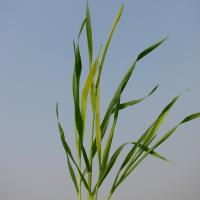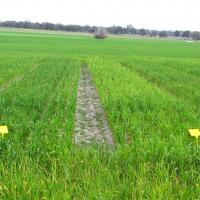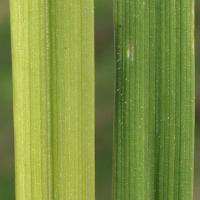Diagnosing sulphur deficiency in cereals
Previous widespread use of superphosphate (which contains 10% sulphur) means sulphur deficiency is rare in Western Australia cereal crops. Early deficiency is occasionally seen in crops growing on sandy soils in wetter areas but plants generally recover without any yield loss. Continual use of compound fertilisers that contain little or no sulphur will increase the risk of sulphur deficiency.
What to look for
- Areas of pale plants.
Paddock
- Plants grow poorly, lack vigour with reduced tillering, delayed maturity and lower yields and protein levels.
- Youngest leaves are affected first and most severely.
- Leaves on deficient plants leaves turn pale with no stripes or green veins but generally do not die and growth is retarded and maturity delayed.
- With extended deficiency the entire plant becomes lemon yellow and stems may become red.
Plant
What else could it be
| Condition | Similarities | Differences |
|---|---|---|
| Diagnosing iron deficiency in cereals | Pale new growth. | Iron deficient plants have interveinal chlorosis. |
| Diagnosing group B herbicide damage in cereals | Seedlings with pale new leaves | Plants generally recover from Group B herbicide damage and leaves often have interveinal chlorosis. |
|
Waterlogging, nitrogen, molybdenum and manganese deficiency
|
Pale growth. | The youngest leaves of sulphur deficient plants are affected first while the middle or older leaves are affected first with waterlogging, manganese, nitrogen and molybdenum deficiency. |
Where does it occur?

Wet conditions
- High rainfall on sandy acidic soils can result in sulphur leaching.
- Cold, wet conditions slow sulphur mineralisation and plant uptake.
Management strategies

Top dressing
- Top-dressing 10-15 kilograms per hectare of sulphur as gypsum or ammonium sulphate will overcome deficiency symptoms.
- Foliar sprays generally can not supply enough sulphur for plant needs.
How can it be monitored?

Tissue test

Soil test

- Use youngest emerged leaf test to determine sulphur status of crop with levels below 0.28% indicative of a deficiency.
- If using a whole-top plant test, levels below 0.15% in whole shoots at the boot stage are likely to be deficient.
- A soil test (Blair KCl 40) of less than 5 milligrams per kilogram in the 0 - 10 centimetres gives an indication of likely sulphur deficiency, but it is unreliable. For many soil types sulphur is found deeper in the profile, hence no yield response with low surface values.
Further information
Where to go for expert help
Page last updated: Friday, 10 July 2015 - 3:24pm




